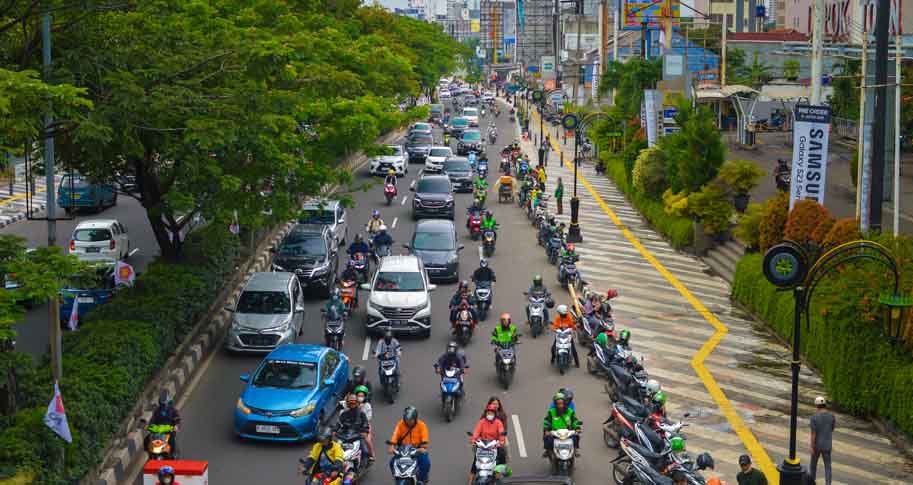
Call it a species of American Exceptionalism, but you’d think given the way all the armchair city planners talk about urban sprawl that it is a uniquely American condition. It is, in fact, a global one. North America’s urban sprawl isn’t even increasing at the fastest rate; Europe’s is. Globally, cities’ footprints are increasing at twice the rate their populations are.
And while there is much to say about the detriments of urban sprawl, often environmental and sometimes health-related, those discussions frequently miss a key point: people and societies are choosing less dense cities for a reason.
Also often missing from these conversations is the impact of sprawl upon countries outside of the industrial core (e.g., the US, Japan, Western Europe, etc.). The populations of Lower- and Middle Income Countries (LMICs) are urbanizing at a rapid rate, and yet, “little is known about how low-density development affects social capital in cities from LMICs,” say University of Arkansas professors, Andrea Civelli and Arya Gaduh, in their recent article, “Urban Sprawl and Social Capital: Evidence from Indonesian Cities.”
Social capital refers to the stock of social trust in communities that facilitate civic participation and collective actions for mutual benefit. Some researchers are concerned that urban sprawl makes it harder for community participation – Robert Putnam’s Bowling Alone (2000) is a now classic work on this phenomenon – and others fear that sprawl gives rise to polarization. In either case, some think that sprawl necessarily leads to a lack of social capital.
On the other hand, some of the earliest sociological research on urbanism found the urban environment itself to be an impediment to social interaction because urban life overloads the sense, and this line of thinking is experiencing a modern revival in psychology. And while some researchers have found density can help foster common feeling, others find that urban residents tend to operate anonymously – that is, not increasing their social capital – due to their diverse backgrounds and custom.
What Civelli, Gaduh, and their coauthors Alexander Rothenberg (Syracuse) and Yao Wang (Ohio State) found in their analysis contradicts some strongly held convictions that pro-density advocates maintain. Namely, higher density reduces trust and community participation. These negative effects were greater for wealthier and more educated individuals.
Indonesian Urbanism
As a background to their study, the researchers offered some facts about Indonesia that makes it a fascinating study of urbanization in LMICs. During the 1980s and 1990s, Indonesia urbanized at a rate of 3% a year, which was faster than any other East Asian country. At the same time, its GDP per capita ballooned from $772 in 1970 to over $2400 in 1997.
Today, 56% of the population, or 151 million Indonesians, live in the country’s urban areas, and its GDP per capita has continued to grow to $3487 (using the same 2010 USD that the researchers used for the above numbers). By 2045, projections suggest about 70% of Indonesia’s population will live in cities.
During this period of rapid urbanization and improving economic circumstances, Indonesian cities experienced similar pressures to ones we would be familiar with in the States. While the urban cores – defined as being surrounded by 50% or more built-up space – saw high economic productivity that attracted migrants, housing costs also increased. These urban residents, then, relocated to suburban communities. Similarly, Indonesian politicians have generally enacted policies that favor motor vehicles by subsidizing gas and building more roads rather than developing public transit.
Particularly interesting for this research is Indonesia’s diversity. It is one of the world’s most diverse countries with more than 1200 self-identified ethnic groups. It also has some of the greatest social capital, ranked 5th out of 167 countries by one measure. Civelli, Gaduh, Rothenberg, and Wang say this is interesting because there are consistent findings which suggest diversity does not correlate with greater social capital. Indonesia, however, while diverse nationally, tends to be homogenous on the local level.
The Dirty Business of Estimating Urban Density
Before they even began digging into the data to measure the effects of sprawl, the researchers needed to confront two confounding problems surrounding urban density: simultaneity and sorting. The researchers acknowledged that social capital and density could be “determined simultaneously…and [that] omitted, place-specific characteristics may drive correlations.” Their study wasn’t measuring the accessibility of nationally recognized art museums or travel hubs, the sorts of amenities that might attract people to live in denser neighborhoods. Rather, the researchers were analyzing what density itself does to social capital.
Likewise, without a very different kind of survey than the census data the researchers were working with, there’s no good way to estimate to what degree people are self-sorting. In Indonesia as elsewhere, less dense communities tend to be more ethnically homogenous, so community members may preselect themselves for their willingness to contribute to local social capital.
In either case, Civelli, Gaduh, Rothenberg, and Wang said that these problems “make it challenging to draw causal inferences from observed correlations between population density and social capital.” For the latter, the researcher instituted robust control values, but to address the former, they needed another proxy value to indirectly measure the likelihood a location would be amenable to a denser urban landscape.
The key there is "landscape." Earlier research already looked at how terrain ruggedness impacted the urban fringe and its population density, so Civelli, Gaduh, Rothenberg, and Wang took soil quality as a proxy metric for a nonhuman density propensity. With an agrarian economy, better soil encourages more people to live in a location, but even after the local economy has become post-agricultural, there’s still a gravitational pull towards the preestablished population.
If you live in Fayetteville with its grid system plopped onto mountainsides, you might be forgiven if you think landscapes don’t overly determine city layouts and densities every time you encounter a 15% grade where a switchback would make more sense. On the other hand, the researchers’ insights suggest there is a reason Fayetteville sprawls north and westward rather than deeper into the Boston Mountains – the Springfield Plateau, upon which rests Springdale, Rogers, and Bentonville, has been a robust agricultural region, while the Ozark Mountains proper have been fairly marginal.
Do Good Fences Make Good Neighbors?
Unfortunately for many urbanists out there, Civelli, Gaduh, Rothenberg, and Wang’s research further contributes to the growing consensus that dense urban environments often have a negative impact upon their residents. Specific to this study, the research found that “in Indonesian cities, increases in density lead to lower levels of trust in neighbours and reduced community participation, echoing the results of Brueckner and Largey.”
Further analysis showed that the negative effects were more pronounced for wealthier and more educated individuals, and the negative relationship between density and social capital was “more pronounced in higher crime cities.”
But rest assured, it’s not all doom and gloom for denser cities. There is one bright spot: the researchers found that denser cities generally lead to higher levels of intergroup tolerance. So, Civelli, Gaduh, Rothenberg, and Wang’s research highlights a trade-off that cities and nations face when they consider how best to construct their urban fabric.
The researchers are quick to caution readers: more research is needed to determine if the relationships they found in Indonesia cities hold up for other LMICs. Likewise, there are other key determinants we need to consider when deciding about the density of our cities, namely energy and land use.
Some urban planners urge soft densification, which is more piecemeal and locality driven, and others have cautioned against viewing density as merely taller buildings, since those have worse emissions. One possible future for our cities is one state over: Houston. While Houston is certainly not the densest city in the United States, it has managed to build density throughout the city in neighborhoods that have the infrastructure to support the newcomers. It’s also one of the U.S.’s most diverse cities.
At any rate, Civelli and Gaduh’s work can help policymakers as they make tough decisions about our urban spaces. As they note, Indonesia is an interesting case study, especially as we learn to appreciate the economic pressures that are shaping usually overlooked societies around the world.





